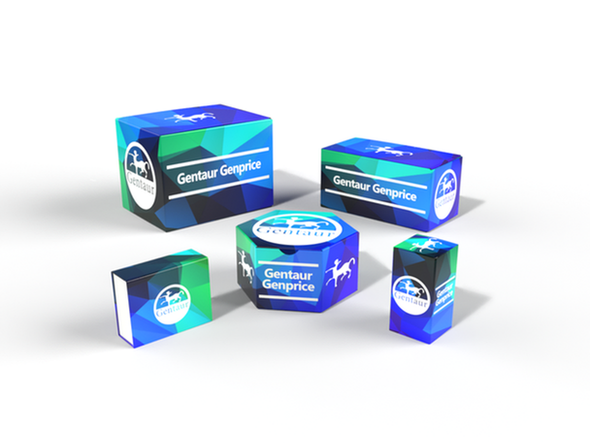LBD
MR1 Antibody (C-term) [APR31523G]
- SKU:
- LBD-APR31523G
- Availability:
- Usually ships in 5 working days
Description
MR1 Antibody (C-term) [APR31523G] | Gentaur UK, US & Europe Distribution
Product Category: Polyclonal Antibodies
Host: Rabbit
Species Reactivity: H
Specificity: This MR1 antibody is generated from rabbits immunized with a KLH conjugated synthetic peptide between 312-341 amino acids from the C-terminal region of human MR1.
Cellular Localisation: Cell membrane; Single-pass type I membrane protein. Endoplasmic reticulum membrane; Single-pass type I membrane protein. Golgi apparatus membrane; Single-pass type I membrane protein. Early endosome membrane; Single-pass type I membrane protein. Late endosome membrane; Single-pass type I membrane protein. Note=In the absence of antigen remains within the endoplasmic reticulum where it acts as a metabolite sensor. Antigen binding triggers trafficking of the ternary complex to the plasma membrane. After presentation, most of these complexes are rapidly internalized and degraded via endocytosis. A small subset recycles via endosomes back to the plasma membrane and may thus acquire and present new antigens that do not efficiently reach the endoplasmic reticulum. [Isoform 3]: Cell membrane; Single-pass type I membrane protein. Endoplasmic reticulum membrane; Single-pass membrane protein. Note=The larger proportion remains in the ER in an immature state. The subset that reach cell surface does it through a B2M-independent pathway.
Molecular Weight: 39366
Clone: Polyclonal
Gene Name: MR1
Gene ID: 3140
Function: Antigen-presenting molecule specialized in displaying microbial pyrimidine-based metabolites to alpha-beta T cell receptors (TCR) on innate-type mucosal-associated invariant T (MAIT) cells (PubMed:23051753, PubMed:26795251, PubMed:12794138, PubMed:19416870, PubMed:22692454, PubMed:23846752) . In complex with B2M preferentially presents riboflavin-derived metabolites to semi-invariant TRAV1-2 TCRs on MAIT cells, guiding immune surveillance of the microbial metabolome at mucosal epithelial barriers (PubMed:26795251, PubMed:24695216, PubMed:20581831) . Signature pyrimidine-based microbial antigens are generated via non-enzymatic condensation of metabolite intermediates of the riboflavin pathway with by-products arising from other metabolic pathways such as glycolysis. Typical potent antigenic metabolites are 5- (2-oxoethylideneamino) -6-D-ribitylaminouracil (5-OE-RU) and 5- (2- oxopropylideneamino) -6-D-ribitylaminouracil (5-OP-RU), products of condensation of 5-amino-6-D-ribityaminouracil (5-A-RU) with glyoxal or methylglyoxal by-products, respectively (PubMed:24695216) . May present microbial antigens to various TRAV1-2-negative MAIT cell subsets, providing for unique recognition of diverse microbes, including pathogens that do not synthesize riboflavin (PubMed:27527800, PubMed:31113973) . Upon antigen recognition, elicits rapid innate-type MAIT cell activation to eliminate pathogenic microbes by directly killing infected cells (PubMed:24695216, PubMed:27527800, PubMed:23846752) . During T cell development, drives thymic selection and post-thymic terminal differentiation of MAIT cells in a process dependent on commensal microflora (By similarity) . Acts as an immune sensor of cancer cell metabolome (PubMed:31959982) . May present a tumor-specific or -associated metabolite essential for cancer cell survival to a pan-cancer TCR consisting of TRAV38.2-DV8*TRAJ31 alpha chain paired with a TRBV25.1*TRBJ2.3 beta chain on a non-MAIT CD8- positive T cell clone (MC.7.G5), triggering T cell-mediated killing of a wide range of cancer cell types (PubMed:31959982) .
Summary: Tissue Location: Ubiquitous (PubMed:7624800, PubMed:9780177) . Low expression is detected in peripheral blood B cells, T cells, monocytes and in bronchial epithelial cells (at protein level) (PubMed:27043408) Expressed in plasmablasts or plasma B cells in the lamina propria of ileum, appendix and colon (at protein level) (PubMed:19760593) . Highly expressed on a subset of CD45-positive CD3-positive thymocytes (at protein level) (PubMed:22692454) .
Form: Purified polyclonal antibody supplied in PBS with 0.09% (W/V) sodium azide. This antibody is purified through a protein A column, followed by peptide affinity purification.
Storage: Maintain refrigerated at 2-8°C for up to 2 weeks. For long term storage store at -20°C in small aliquots to prevent freeze-thaw cycles.
Application: WB
Dilution: WB--1:1000 WB--1:500
Synonyms: Major histocompatibility complex class I-related gene protein, MHC class I-related gene protein, Class I histocompatibility antigen-like protein, MR1

![MR1 Antibody (C-term) [APR31523G] MR1 Antibody (C-term) [APR31523G]](https://cdn11.bigcommerce.com/s-1rdwiq712m/images/stencil/608x608/products/62666/62970/gentaur-genprice__26005.1661610467__29809.1661628092__75433.1661676199__77988.1661684280__64362.1661692443__61807.1661865747.png?c=1)




